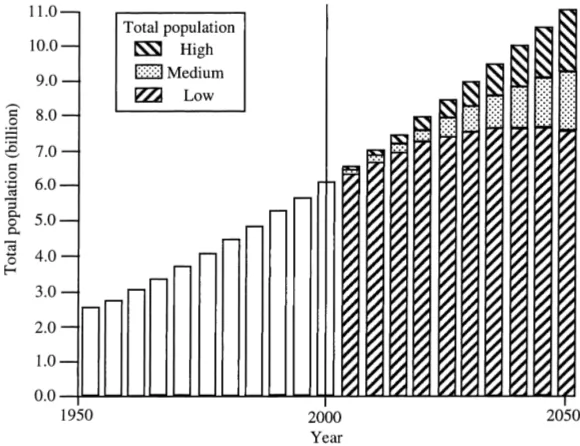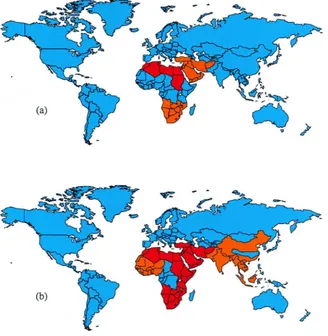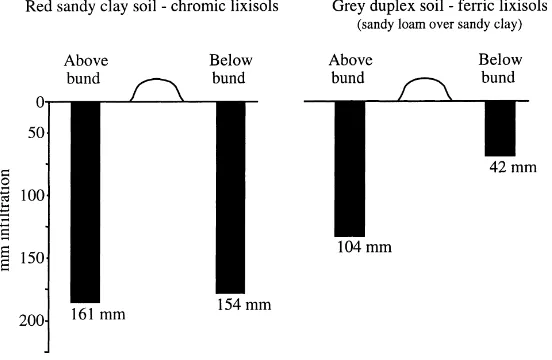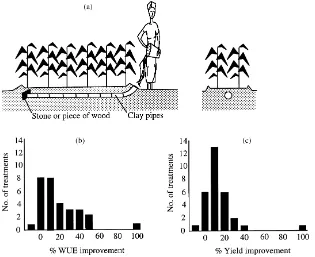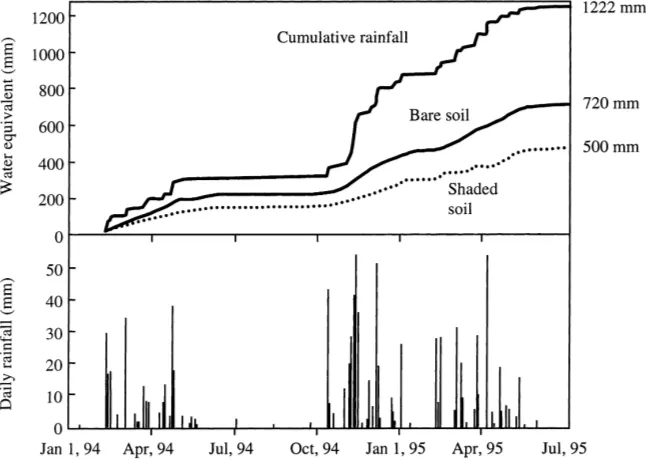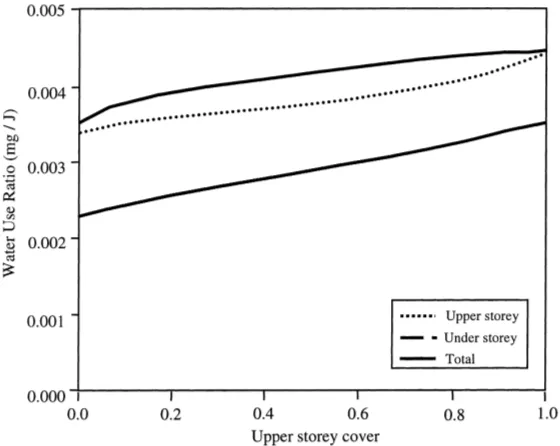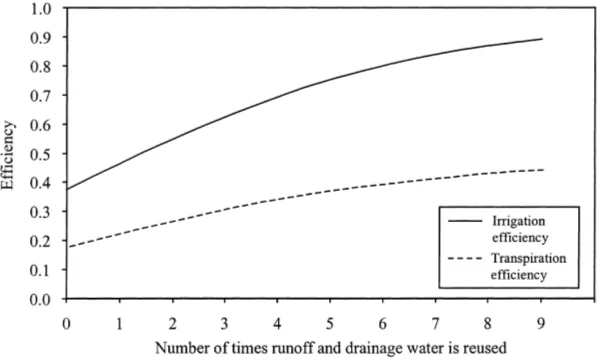Increasing agricultural water use efficiency to
meet future food production
J.S. Wallace
∗Centre for Ecology and Hydrology, Wallingford, Oxfordshire OX10 8BB, UK
Abstract
With the world’s population set to increase by 65% (3.7 billion) by∼2050, the additional food required to feed future generations will put further enormous pressure on freshwater resources. This is because agriculture is the largest single user of fresh water, accounting for∼75% of current human water use. At present∼7% of the world’s population live in areas where water is scarce. This is predicted to rise to a staggering 67% of the world’s population by 2050. Because of this water scarcity and because new arable land is also limited, future increases in production will have to come mainly by growing more food on existing land and water. This paper looks at how this might be achieved by examining the efficiency with which water is used in agriculture. Globally, in both irrigated and rain fed agriculture only about 10–30% of the available water (as rainfall, surface or groundwater) is used by plants as transpiration. In arid and semi-arid areas, where water is scarce and population growth is high, this figure is nearer 5% in rain fed crops. There is, therefore, great potential for improving water use efficiency in agriculture, particularly, in those areas where the need is greatest. The technical basis for improving agricultural water use efficiency is illustrated. This may be achieved by increasing the total amount of the water resource that is made available to plants for transpiration and/or by increasing the efficiency with which transpired water produces biomass. It is concluded that there is much scope for improvement, particularly, in the former and that future global change research should shift its emphasis to addressing this real and immediate challenge. © 2000 Elsevier Science B.V. All rights reserved.
Keywords: Global change; Population increase; Agriculture; Water use efficiency
1. Introduction
To date the global change community has had a strong focus on the causes and impacts of increased at-mospheric CO2level, i.e. global warming and climate
change. This focus has drawn together an impressive body of international research effort and has made very significant progress in studying the physical and physiological processes which are central to under-standing the effects of atmospheric CO2increase on
vegetation. This research underpins the design of ef-fective mitigation strategies. However, one
disadvan-∗Fax:+44-1491-692424.
E-mail address: [email protected] (J.S. Wallace).
tage of this strong ‘carbon’ focus is that other im-portant global issues have, by default rather than by design, received much less attention. This paper ar-gues that the Earth is facing another important global change, which is both more important and more cer-tain than changing atmospheric CO2 concentration.
This change is the massive increase in world popula-tion which will occur within the next 50 years. This has many far reaching implications for both science and society, but one central issue is the challenge of growing enough food for this increased population when water resources are limited and already highly exploited, particularly, in those areas of the world where the population increase is greatest. The techni-cal research agenda which evolves from these water
resource implications is identified as one of agricul-tural water use efficiency. The current levels of water use efficiency are outlined and used to demonstrate the scope for improvement. Examples of the technical ba-sis for improved water use efficiency are given; these show how runoff, soil evaporation and drainage may be reduced in order to optimise the amount of water re-tained in the soil to support plant growth. The issue of water use efficiency and scale is also discussed, show-ing how the large scale (e.g. catchment) water use ef-ficiency may be increased by recycling run off and/or drainage. Finally, there is a plea to the global change community to apply some of its intellectual capac-ity to addressing the technical agenda which evolves from the agricultural water use efficiency problem. This agenda is not only scientifically and technically challenging, but is also of major importance in con-tributing to the solutions to what is arguably one of the most pressing global issues currently facing mankind.
2. The most important global change
Fig. 1 is based on United Nations Population Di-vision data and shows that the total population of the world has increased by 125% since 1950 (Fischer and
Fig. 1. Historic and future world population. Source: UN Population Division 1997 (Fischer and Heilig, 1997).
Heilig, 1997). This figure also shows the best available estimates of how the world population will increase in the next 50 years. As these are estimates, three scenari-os are presented based on different assumptions about fertility rates in women. The most optimistic scenario is for a low fertility rate where the world population will increase by∼2 billion or 35%. The median pro-jection is for an increase of 65% or an extra 3.7 billion people. If female fertility rates remain high, then the world population would double by 2050.
Two other factors need to be pointed out. Firstly, most of the world population increase will occur within the next 25–30 years. This is a very short time to prepare for the huge impacts which will be described later. Secondly, almost all of the world’s population increase will be in developing countries. Fischer and Heilig (1997) have pointed out that this developing world ‘population explosion’ is a histori-cally unique phenomenon. No European country has ever experienced such high population growth rates or absolute numbers, even during their fastest growth pe-riods. In one sense, Fig. 1 is the equivalent to the time trend in atmospheric CO2 concentration measured at
the Mauna Loa observatory in Hawaii. More than any other single illustration of the atmospheric CO2
line conveyed the nature and urgency of the CO2
is-sue. Although it does not oscillate, the massive and inexorable increase in the number of human beings in the world should be recognised for what it is — the most important global change facing mankind.
3. Water resource implications
Assuming the median population projection (Fig. 1), what are the water resource implications of having 3.7 billion more people in the world? These are largely associated with the water needed to grow their food, since large amounts of water are associ-ated with food production. Shiklomanov (1991) has estimated that at present around three-quarters of the annual renewable freshwater resources used by man are consumed in irrigated agriculture. To estimate the inevitable increased demand for water resources to grow the food requirement of the future population, we first need to estimate how much water is required to grow our basic per capita food requirement. If we combine this information with the UN popula-tion statistics and estimates of total annual renewable freshwater resources, we can estimate the global and regional picture of future water scarcity.
Table 1 reproduces some data presented by Falken-mark (1997) which was used to derive basic per capita water requirements. This assumes a basic dietary re-quirement of 2700 kcal which is mostly (85%) plant based. Using figures for the water requirement per kcal of food, Falkenmark (1997) was able to estimate the annual per capita water requirement as 1570 m3 wa-ter. In a semi-arid climate Falkenmark assumes that 50% of food would come from rain fed agriculture, so the annual per capita freshwater demand from irri-gated agriculture would be 785 m3. This is a critical
Table 1
Water requirements for food per capitaa
Food Plant-based Animal-based Total
Daily amount (kcal) 2300 400 2700
Daily water required per 1000 kcal (m3) 1 5 –
Daily actual water requirement (m3) 2.3 2.0 4.3
Annual water requirement (m3) 840 730 1570
Assume 50% irrigated production (m3) – – 785
aSource: FAO (see Falkenmark, 1997).
assumption in this analysis, which may be a reason-able ‘first estimate’ for all semi-arid areas. However, it will clearly vary widely between different parts of the semi-arid zone. Another point which will be de-veloped further in a later section is the need to take more account of rain fed agriculture when considering future food production and its water resource impli-cations. In simple terms the more that is grown under rain fed agriculture the less the demand on freshwater resources will be.
Falkenmark (1997) also made some allowance for domestic water requirements, i.e. 36 m3 per person per year, and a per capita industrial allowance of 180 m3 per person per year. The total annual per capita water requirement is therefore∼1000 m3. As this is regarded as a basic requirement, some water stress is still considered to occur when the annual per capita water availability is between 1000 and 2000 m3. Above 2000 m3per person there is usually little or no water stress.
Fig. 2. Global water scarcity (a) now and (b) in 2050. Regions are coded according to their per capita annual renewable freshwater resource. Red-less than 1000 m3per person per year, orange-between 1000 and 2000 m3per person per year and blue-greater than 2000 m3 per person per year: data from Fischer and Heilig (1997).
one in six of the Earth’s population will have insuf-ficient water to meet their basic requirements. This situation is predicted to extend over large regions of Africa and the Middle East. Other areas with currently sufficient water will experience some degree of wa-ter shortage, e.g. India, Far East and parts of China. Over the entire globe a staggering 67% of the future population of the world may experience some water stress; 10 times the number of people who are in this situation today! As the use of water for human needs increases, there are potentially severe environmental consequences due to shortages of fresh water for wet-lands and other aquatic ecosystems. Human use of wa-ter also tends to degrade wawa-ter quality, which again can
have important impacts on ecological systems. How-ever, here we will focus on water use in agriculture.
Table 2
Estimates of the water-use efficiencies of irrigated and rainfed agriculture in semi-arid areasa Irrigated agriculture (Fraction of available waterb (%))
Rainfed agriculture (Fraction of rainfall (%))
Storage and conveyancing 30 0
Runoff and drainage 44 40–50
Evaporation (from soil or water) 8–13 30–35
Transpiration 13–18 15–30
aBased on data given in Wallace and Batchelor (1997) and reproduced from Falkenmark et al. (1998). bRainfall and stored surface or groundwater.
4. Agricultural water use efficiency
A summary of the current efficiency with which wa-ter is used in both rain fed and irrigated agriculture is given in Table 2. In irrigated agriculture, a consi-derable amount of water is lost as evaporation and/or leakage during storage and transport of the water to the fields where the crops are grown. Bos (1985) has estimated that globally ∼30% of irrigation water is lost in storage and conveyancing. Once the remain-ing (70%) water reaches the field where it is required there are further losses as runoff and/or drainage. Pos-tel (1993) has estimated the world wide irrigation effi-ciency, i.e. the amount of water evaporated compared to the amount of water delivered to the field, to be
∼37%. This would mean 63% of the water delivered to field is lost as runoff and/or drainage. This equates to 44% of the total water resource at source. Broadly similar figures demonstrating the poor performance of most irrigation systems have also been published by the Food and Agriculture Organisation (e.g. see Bargh-outi, 1999). However, some of the water “lost” from an irrigated field may return to aquifers or streams from which it can be abstracted again, provided the neces-sary infrastructure is available and the water quality has not deteriorated beyond acceptable limits. If this is the case the efficiency of water use over large irrigated areas may be greater than the above global mean of field level irrigation efficiencies (Bouwer, 1992). This important issue is discussed further in the section on Water Use Efficiency and Scale.
Conventional irrigation efficiencies are quoted as the ratio of water evaporated to that supplied to the field. However, of the total water evaporated during a crop season, only a fraction is transpired by the crop. For example, in flood irrigated maize (Zea mays) in Zimbabwe, Batchelor et al. (1993) found that
eva-poration from the wet soil was∼50% of the total sea-sonal evaporation. The lowest direct evaporation losses might be expected to occur in fast growing irrigated rice (Oryza sativa). However, even here around 30% of the season’s total evaporation is from the water in which the rice is growing (Batchelor and Roberts, 1983). If these two figures for irrigated maize and paddy rice are typical, this implies that between 8 and 13% of the initial water resource is lost as direct eva-poration from the soil or open water supporting the crop. This fairly crude analysis results in the conclu-sion that globally only 13–18% of the initial water re-source in irrigated agriculture is used as transpiration by the crop. The amount of water transpired is impor-tant, since in essence it is only the water which passes through the crop as transpiration which is associated with growth and yield.
and Batchelor (1997) for millet grown in research plots in Niger. These figures imply that transpira-tion from rain fed crops in sub-Saharan conditranspira-tions is likely to be between 15 and 30% of rainfall. The amount of rainfall used as transpiration may be even lower in typical farmers fields in West Africa, where Rockstrom (1997) found transpiration was as low as 5% of rainfall.
Water resources are, therefore, very inefficiently used in both rain fed and irrigated agriculture. How-ever, although these low efficiencies may seem disap-pointing, the fact that they are so low provides plenty of scope for improvement and ultimately the hope that it will be possible to grow more food with existing water resources. For example, if the amount of rainfall used as transpiration could be increased from 5 to 10% in sub-Saharan Africa, a not unreasonable target, then yields in this region could be doubled. The problem of producing the food for future populations, therefore, becomes more tractable and the focus becomes one of increasing the efficiency with which water is used in agriculture.
It is important to recognise the need to increase wa-ter use efficiency in both rain fed and irrigated agri-culture. The Food and Agriculture Organisation (FAO) have forecast that by the year 2000 around 84% of the world’s agricultural land will be rain fed and this will yield around two thirds of global crop produc-tion (Postel, 1993). This global figure includes tem-perate areas where rain fed yields are relatively high. In semi-arid developing countries, therefore, the pro-portion of food which comes from rain fed agriculture will be even higher and in some countries is over 90%. Furthermore most of the predicted increase in world population is in these regions, so improving rain fed agriculture will increase production in the areas where the food is most required. Furthermore, the more food which is produced in rain fed agriculture the less the pressure will be on freshwater resources for irrigated agriculture. In the earlier analysis of future world wa-ter scarcity, the assumption was made of 50% food supply from irrigated agriculture. The lower this fig-ure the lower the per capita water requirement and the fewer the areas of the world where water will be scarce. To emphasise the need to focus on rain fed agriculture, particularly, in semi-arid areas, most of the examples in the following section come from this agricultural sector.
5. The technical basis for improvement
In principle, there are only two ways of increasing water use efficiency in agriculture. First, it may be possible to use more of the water resource as transpi-ration. Second, it may be possible to fix more carbon per unit of water transpired. For clarity, it is worth considering these two possibilities separately.
5.1. Increasing transpiration
More of the initial water resource can be routed into transpiration by reducing any of the water losses which occur before or when the water reaches the field where the crop is grown. Following the approach used by Gregory et al. (1997), the water use efficiency (WUE) of a crop can be written as
WUE= ew
{1+(L+Es+R+D)/Et}
(1)
where WUE is defined as the amount of biomass (W) produced per unit of water resource (as rainfall, sur-face or groundwater); L the losses in storage and con-veyancing; Esevaporation from the soil (or open water
in paddy rice etc.); R runoff; D drainage from the crop root zone and Etthe crop transpiration; ewthe
‘transpi-ration efficiency’ or the ‘water use ratio’, i.e. the ratio of the amount of carbon fixed by a plant per unit of water transpired (W/Et). A range of physical
engineer-ing, hydrological and agronomic techniques can be applied to maximise Et and minimise L, Es, R and D.
Plant physiological techniques and micro-climate ma-nipulation can be used to increase ew(see later). Let us
first consider the physical means of increasing WUE. The four ways of potentially increasing transpira-tion are therefore by reducing L (in irrigated agricul-ture), and by reducing R, Es and D (in both irrigated
and rain fed agriculture). Storage and conveyancing losses in irrigated agriculture may be reduced using a range of engineering or management techniques which decrease evaporation and leakage from reservoirs and irrigation channels. Details of these techniques are out-side the scope of this paper, but are well documented in the irrigation engineering and water resources man-agement literature.
Table 3
The effect of soil tillage on runoff from sandy soils in West Africaa Year Rainfall
(mm)
Runoff (no tillage (mm))
Runoff (with tillage (mm))
1977 368 155 76
1978 271 104 49
1979 361 141 80
Average 333 133 68
aSource: Stroosnijder and Hoogmoed (1984).
poor infiltration rates, high amounts of surface runoff are to be expected. However, even in the low rainfall climate of West Africa, runoff from flat fields with very sandy soils can be very significant. For exam-ple, Rockstrom (1997) found runoff totalled 25–30% of annual rainfalls between 490 and 600 mm in rela-tively flat (2–3% slope) sandy millet fields in Niger. Even higher runoff amounts, up to 40% of annual rain-falls of 270–370 mm, were reported by Stroosnijder and Hoogmoed (1984) for similar sandy land in Mali (Table 3).
Runoff can be reduced by increasing surface storage and/or the soil infiltration rate. These can be achieved by mechanical changes to the soil surface or the addi-tion of extra materials to the surface, or both. The most striking mechanical change is terracing. This has been used very successfully for hundreds of years in upland paddy rice systems in Asia. Less radical mechanical
Fig. 3. The effect of soil bunding on infiltration in south-east Zimbabwe following a rainfall event of 141 mm. Note the infiltration on the clay soil is greater than the rainfall due to runoff to the area above the bund (data from Butterworth, 1997, reproduced from Wallace and Batchelor, 1997).
frequency and amount of rainfall. In conclusion there-fore, although the principles of the techniques used to reduce runoff are well known, the above examples illustrate the need for research into the effects of sur-face treatments on runoff processes so that appropriate and effective measures can be applied in the correct circumstances.
Reductions in direct evaporation of water from the soil (or open water) surface could also improve the ef-ficiency with which water is used in agriculture. One simple way of achieving this is to reduce the number of irrigation applications. Alternatively, in irrigated agriculture where there is adequate finance, another solution is to use modern ‘high tech’ systems such as drip irrigation. One of the reasons these systems work is because there is less wet soil surface exposed to the atmosphere and hence less soil evaporation. Highly expensive systems may not be applicable in some areas, but the same principles of reducing the exposure of wet soil can be applied. For example, the high soil evaporation losses, cited earlier (Batchelor et al., 1993) from flood irrigated maize were reduced
Fig. 4. The improvement in (b) water use effectiveness (WUE) and (c) yield in a total of thirty subsurface and flood irrigated treatments carried out in the Lowveld region of Zimbabwe between 1989–1994: from Batchelor et al. (1996).
by applying water to the crop using simple unglazed clay pipes buried beneath the soil surface, Fig. 4(a). These pipes were made locally at very low cost and significantly improved water use efficiency and crop yield. This is shown in Fig. 4(b), where most of the 30 crop treatments studied showed improved water use efficiency and yield under subsurface irrigation compared with flood irrigation.
Fig. 5. Cumulative evaporation from bare soil and soil beneath a tree canopy calculated using a model based on the Richie (1972) approach. Rainfall and cumulative rainfall are also shown (reproduced from Wallace and Batchelor, 1997).
over fields where the tillage produced a high degree of soil disturbance which exposed large amounts of moist soil to drying. Clearly, tillage can have an im-portant effect on soil evaporation, but its net result will depend on soil type and water content, tillage practice and the weather over the period considered.
Soil evaporation can also be reduced by decreasing the amount of energy reaching the soil surface. This can be achieved using shade from the crop canopy itself or by growing crops under trees in agroforestry systems. For example, measurement and modelling of soil evaporation in a Grevillea robusta agroforestry system in Kenya has demonstrated the potential for re-ducing soil evaporation using canopy shade (Wallace et al., 1999). Fig. 5 shows a time series of cumulative evaporation from bare soil and tree canopy shaded soil for an 18 month period. Without any canopy shade∼59% of the rainfall is lost as soil evaporation. Directly beneath the tree shade soil evaporation is reduced to 41% of rainfall. The agroforestry system studies had ∼50% ground cover, therefore, the net effect of the trees was to reduce the area average soil evaporation by∼117 mm per year, equivalent to 15% of rainfall. This substantial saving in water decreases
as canopy cover decreases, but clearly demonstrates the potential for improved water use which can be achieved by increasing ground cover in rain fed agri-cultural and agroforestry systems. Again as with the techniques for reducing runoff, the basic techniques for reducing soil evaporation are known, but the suit-ability and net effect of a particular approach in a given environment require further study.
Table 4
Model calculations of annual drainage from rainfed millet in West Africaa
Gao Tillaberi Niamey Gaya
Rainfall P (mm) 217 445 595 746
Drainage D (mm) 3 83 157 272
D/P (%) 1 19 26 36
aFrom Bley et al. (1991).
to less than∼200 mm did drainage become insignif-icant. Drainage from farmer’s fields may be even higher (40–50% of rainfall) than the figures deduced from Bley’s research station experiments due to poorer crop development and local redistribution of runoff in farmer’s fields (Rockstrom, 1997; Gregory et al., 1997). For crops growing on the Deccan plateau in India Ong et al. (1991) reported that the best crop-ping systems still lost∼33% of rainfall as drainage.
Reduction of drainage losses in rain fed and irri-gated crops is difficult as it is dependent on the rapid development of annual root systems. However, peren-nial species such as shrubs and trees generally have deeper root systems which can be much more effec-tive in abstracting soil water and reducing drainage. Gash et al. (1997) found indirect evidence for this in natural savannah, a mixture of perennial shrubs and annual grasses, growing south of Niamey, Niger. They found that seasonal evaporation from millet was 30% less than that from a nearby savannah area. This difference is similar to the drainage loss from millet calculated above by Bley et al. (1991). It is, therefore, reasonable to conclude that the savannah vegetation had minimal drainage due to the ability of the peren-nial shrubs to abstract water from depth in the soil. Drainage is, therefore, one of the hydrological terms which can be highly modified by the presence of trees or other perennial vegetation. Since trees can, in principle, utilise water outside the rooting zone of annual crops and also outside the crop growing season, they have the potential of increasing water use efficiency when mixed with crops in agroforestry systems. Research is needed to identify crops which have rapid root development, especially in terms of exploiting soil depth. There is also a need to study and find tree/crop mixtures which are viable and at the same time make better use of the available water resources.
5.2. Increasing the transpiration water use ratio
The alternative way of increasing agricultural water use efficiency is by increasing the transpiration water use ratio, ew (see Eq. (1)). This is inversely
propor-tional to the mean saturation deficit of the atmosphere,
d (Monteith, 1986),
ew=
k
d (2)
where k is a physiological characteristic specific to a given crop. Total dry matter production (per unit area in a given time) is simply the product of Et and ew,
where Et is the transpiration. Theoretical
consider-ations and experimental studies have shown that (at least under fairly idealised conditions) the product ew d is quite conservative among species groups
(Ong et al., 1996). For example, in C3 species ew d is ∼4 kg mm−1kPa and about twice this
(8 kg mm−1kPa) in C4 species (Squire, 1990). The net effect of atmospheric humidity on any given species is therefore one of the most important factors affecting productivity, since dry matter production per unit of water transpired decreases by a factor of two as satu-ration deficit increases from ∼2 in moist temperate climates to∼4 kPa in semi-arid areas (Squire, 1990). Eq. (2) shows that there are two ways that agricul-tural production could be increased by increasing ew.
The first is by increasing k, the physiological charac-teristic which depends on the biochemistry control-ling the photosynthetic processes in plant cells. This may be achieved by plant selection (e.g. C3 or C4 species), or by breeding or genetically engineering crops with a higher value of k. The second way to increase ewis to reduce d, either by manipulating the
crop water use efficiency are to be had by putting greater emphasis on water management and irrigation technology in humid areas. The use of water for sup-plementary irrigation is one example of this type of approach.
There are also possibilities for reducing d by manipulating the micro-climate around crop. For ex-ample, in agroforestry systems the presence of an elevated tree canopy may alter not only the humi-dity, but also the radiation and temperature around an understorey crop. Some evidence for this has been found where crops have been grown using trees as shelter belts, and decreases in d have been reported for several crops (Brenner, 1996). Data from an agro-forestry trial in Kenya also show that the air around a maize crop growing beneath a Grevillea robusta stand is more humid than the free atmosphere above the trees (Wallace et al., 1995). Wallace and Verhoef (2000) have used an agroforestry model to predict the effect of tree cover on the water use ratio of an understorey crop. Fig. 6 shows the results of their simulation which predicts that both the crop and tree water use ratios will increase by ∼25% as the tree cover increases from 0 to 1. The total system water use ratio includes the evaporation from the soil, so it
Fig. 6. Variation of water use ratio with upper storey fractional ground cover in a two species mixture with a dominant upper storey (from Wallace and Verhoef, 2000).
is lower than the water use ratios of the component species. However, this also increases by ∼25% in this simulation. Clearly, this improved micro-climate is only of benefit to the crop as long as there is ade-quate water in the soil to meet both the tree and crop requirements. This highlights the need to identify the tree/crop mixtures and soil and climate combinations within which this may be the case.
crop yield, assuming for simplicity, that the harvest index remained constant and factors other than water are not limiting yield. In contrast a 10% improvement in transpiration water use ratio, would not increase the fraction of the total water resource water used in transpiration, and would only produce a potential 10% increase in yield. When the amount of the total water resources used as transpiration is low (i.e. ∼15%), then improvements in the quantity of water transpired are likely to produce greater efficiency gains than improvements in the transpiration water use ratio.
6. Water use efficiency and scale
The above techniques for improving water use effi-ciency can be considered in terms of different spatial scales. At the smallest scale of an individual plant the transpirational water use efficiency is most applica-ble. Here breeding and genetic manipulation may be used to improve growth per unit of water transpired. Moving up in scale to groups of plants, water use effi-ciencies can be a mixture of improvement in transpi-rational water use efficiency, e.g. as might be achieved by the micro-climatic modification resulting from mutual shading in a plant community or by reductions in soil evaporation, runoff or drainage which may be achieved using complementary plant mixtures, as in intercropping or agroforestry. These ‘field’ scale
effi-Fig. 7. Change in irrigation efficiency with reuse of runoff and drainage water. Assumed 50% of runoff and drainage is recycled.
remains much lower than this and can never reach such high values unless the proportion of water which is evaporated directly from the soil (or open water surface) is reduced. The research requirements from this area centre on the need to identify appropriate ways of reducing soil (and open water) evaporation as well as how much run off and/or drainage from a given area is reusable.
Moving up further in scale to a complete landscape also allows techniques other than recycling to be con-sidered as a means of increasing the overall water use efficiency of a large area. For example, deliberately allowing water to move from one part of a landscape to another may result in an improvement in the over-all efficiency with which water is used. For example, where rainfall is too low to grow a viable crop over an entire area, it may be possible to channel water from bare areas to another point in the catchment where there is sufficient water to grow a crop. These ‘wa-ter harvesting’ techniques have been used in ancient agricultural systems and can still be seen in parts of sub-Saharan Africa today. A modern dimension to this reallocation of water arises from the concept of us-ing limited water resources for crops with the highest value. The particular crops will vary with location and will depend on local markets. When the highest value commodities are not stable food crops, the money gen-erated can be used to buy food, and if this comes from outside the region it effectively reduces the indige-nous per capita water requirement. This is the case in Israel, where despite a per capita water supply of only 300–400 m3per year, there is a sufficient supply of staple foods as these are imported. This has been referred to as trade in ‘virtual water’ and can offer a solution to local water scarcity provided the countries economy is suitable. The generic research question in this area focuses on achieving overall efficiency gains by assessing the way in which water can be used in different places and at different times across an entire catchment.
The above ‘field’, catchment and regional scale effi-ciencies may optimise water use within the areas con-cerned, but may have a detrimental impact on areas outside these areas. For example, Falkenmark et al. (1999) have pointed out that there may be serious downstream impacts of irrigation schemes; the ex-tensive environmental degradation in the Aral Sea is probably the most well known example. Ultimately
complete hydrological systems, including surface and groundwater, need to be considered if the full range of human and environmental demands on the water environment are to properly assessed. Where there is insufficient water to meet all demands, the effect of sub-optimal supply on each sector will need to be quantified before informed and balanced judgements can be made on how to allocate the water resources.
7. Conclusions
solutions to practical implementation in the field. There can be no greater global challenge today on which physical and social scientists can work together than the goal of producing the food required for future generations. A concerted focus on improving water use efficiency in agriculture will increase the productivity of both rain fed and irrigated agriculture. The prize is that more areas of the world, and especially those arid and semi-arid areas where population growth is great-est, will be able to sustain their future populations.
References
Barghouti, S., 1999. Growing Challenges to Water Resources Management. Sustainable Development International, Launch Edition, Spring, 1999, pp. 43–52.
Barros, L.C.G., Hanks, R.J., 1993. Evapotranspiration and yield of beans as affected by mulch and irrigation. Agron. J. 85, 692–697.
Batchelor, C.H., Roberts, J.M., 1983. Evaporation from the irrigation water, foliage and panicles of paddy rice in north-east Sri Lanka. Agric. Meteorol. 29, 11–26.
Batchelor, C.H., Lovell, C.J., Murata, M., 1993. Micro-irrigation techniques for improving irrigation efficiency on vegetable gardens in developing countries. ICID Workshop on Micro-irrigation, The Hague, pp. 31–39.
Batchelor, C.H., Lovell, C.J., Murata, M., 1996. Water use efficiency and simple subsurface irrigation systems, In: Proceedings of 7th International Conference on Water and Irrigation, Tel Aviv, Israel, May 1996.
Bley, J., van der Ploeg, R.R., Sivakumar, M.V.K., Allison, B.E., 1991. A risk-probability map for millet production in Southwest Niger. In: Sivakumar, M.V.K., Wallace, J.S., Renard, C., Giroux, C. (Eds.), Soil Water Balance in the Sudano-Sahelian Zone. IAHS, Wallingford, UK, pp. 571–581.
Bos, M.G., 1985. Summary of ICID definitions on irrigation efficiency. ICID Bull. 34, 1.
Bouwer, A., 1992. Agricultural and municipal use of waste water. Water Sci. Technol. 26, 1583–1591.
Brenner, A.J., 1996. Micro-climatic modifications in agroforestry. In: Ong, C.K., Huxley, P.A. (Eds.), Tree–Crop Interactions — A Physiological Approach. CAB International, Wallingford, UK, pp. 159–187.
Butterworth, J.A., 1997. Hydrology of a dryland catchment in southern Zimbabwe and impacts of climatic variation and land use change in shallow groundwater resources. Ph.D. Thesis, University of Reading, UK.
Falkenmark, M., 1997. Meeting water requirements of an expanding world population. Phil. Trans. R. Soc. London B. 352, 929–936.
Falkenmark, M., Klohn, W., Lundqvist, J., Postel, S., Rockstrom, J., Seckler, D., Shuval, H., Wallace, J., 1998. Water scarcity as a key factor behind global food insecurity: round table discussion. Ambio 27, 2.
Falkenmark, M., Anderson, L., Castensson, R., Sundblad, K., Batchelor, C., Gardiner, J., Lyle, C., Peters, N., Pettersen, B., Quinn, P., Rockstrom, J., Yapijakis, C., 1999. Water — a reflection of land use. Options for countering land and water mismanagement. Swedish Natural Science Research Council, Stockholm.
Fischer, G., Heilig, G.K., 1997. Population momentum and the demand on land and water resources. Phil. Trans. R. Soc. London, B. 352, 869–889.
Gash, J.H.C., Kabat, P., Monteny, B.A., Amadou, M., Bessmoulin, P., Billing, H., Blyth, E.M., deBriun, H.A.R., Elbers, J.A., Friborg, T., Harrison, G., Holwill, C.J., Lloyd, C.R., Lhomme, J.-P., Moncrief, J.B., Puech, D., Soegaard, H., Taupin, J.D., Tuzet, A., Verhoef, A., 1997. The variability of evaporation during the HAPEX-Sahel Intensive Observation Period. J. Hydrol. 188/189, 385–399.
Gleick, P.H., 1993. Water in Crisis. A Guide to the World’s Fresh Water Resources. Oxford University Press, New York. Gregory, P.J., Warren, G.P., Simmonds, L.P., 1997. Interactions
between plant nutrients, water and carbon dioxide as factors limiting crop yields. Phil. Trans. R. Soc. London, B. 352, 987– 996.
Hammel, J.E., Papendick, R.I., Campbell, G.S., 1981. Fallow tillage effects on evaporation and seed zone water content in a dry summer climate. Soil Sci. Am. J. 45 (6), 1016–1022. Hatfield, J.L., Prueger, J.H., Sauer, T.J., 1996. Comparison of
evapotranspiration equations over different surfaces. In: Camp, C.R., Sadler, E.J. (Eds.), Proceedings of the Evapotranspiration and Irrigation Scheduling Conference ASAE, St. Joseph, MI, USA, pp. 1065–1070.
Kiepe, P., Rao, M.R., 1994. Management of agroforestry for the conservation and utilisation of land and water resources. Outlook Agric. 23, 17–25.
Lal, R., 1989. Agroforestry systems and soil surface management of a tropical alfisol. II. Water runoff, soil erosion and nutrient loss, soil erosion and nutrient loss. Agrofor. Syst. 8, 97–111. Lal, R., 1991. Current research on crop water balance and
implications for the future. In: Sivakumar, M.V.K., Wallace, J.S., Renard, C., Giroux, C. (Eds.), Proceedings of the Niamey Workshop on Soil Water Balance in the Sudano-Sahelian Zone, February 1991, IAHS, Wallingford, UK, pp. 31–44.
Monteith, J.L., 1986. How do crops manipulate water supply and demand? Phil. Trans. Roy. Soc. London, B. 316, 245–259. Ong, C.K., Odongo, J.C.W., Marshall, F., Black, C.R., 1991. Water
use by trees and crops: five hypothesis. Agrofor. Today 3, 7–10. Ong, C.K., Black, C.R., Marshall, F.M., Corlett, J.E., 1996. Principles of resources capture and utilisation of light and water. In: Ong, C.K., Huxley, P.A. (Eds.), Tree–Crop Interactions — A Physiological Approach. CAB International, Wallingford, UK, pp. 73–158.
Postel, S.L., 1993. Water and agriculture. In: Gleick, P.H. (Ed.), Water in Crisis: A Guide to the World’s Fresh Water Resources. Oxford University Press, Oxford, pp. 56–66.
Richie, J.T., 1972. Model for predicting evaporation from a row crop with incomplete cover. Water Resources Res. 8, 1204– 1213.
water use efficiency of pearl millet. Ph.D. Thesis, University of Stockholm, Sweden.
Seckler, D., 1996. The new era of water resources management: from dry to wet water savings. Research Report 1. International Irrigation Management Institute, Colombo, Sri Lanka. Seckler, D., 1999. Water for food in 2025: the major issues.
Newsflow. Global Water Partnership. Stockholm, Sweden 2/99, pp. 1–3.
Shiklomanov, I.A., 1991. The world’s water resources. In: Proceedings of the International Symposium to Commemorate 25 Years of the IHP. UNESCO/IHP, pp. 93–126.
Squire, G.R., 1990. The Physiology of Tropical Crop Production. CAB International, Wallingford, UK.
Stroosnijder, L., Hoogmoed, W.B., 1984. Crust formation on sandy soils in the Sahel. II. Tillage and its effect on the water balance. Soil Tillage Res. 4, 321–337.
Tanner, C.B., Sinclair, T.R., 1983. Efficient water use in crop production: research or re-search? In: Taylor, H.M., Jordan,
W.R., Sinclair, T.R. (Eds.), Limitations to Efficient Water Use in Crop Production. Am. Soc. of Agron., Crop Sci. Soc. Am., and Soil Sci. Soc. Am., pp. 1–27.
Wallace, J.S., Batchelor, C.H., 1997. Managing water resources for crop production. Phil. Trans. R. Soc. London, B. 352, 937–947. Wallace, J.S., Verhoef, A., 2000. Modelling interactions in mixed-plant communities: light, water and carbon dioxide. In: Marshall, B., Roberts, J.A. (Eds.), Leaf Development and Canopy Growth. Sheffield Academic Press, Sheffield, pp. 204–250.
Wallace, J.S., Jackson, N.A., Ong, C.K., 1995. Water balance of agroforestry systems on hillslopes. Final Report to the ODA Forestry Research Programme, September 1995. Report No. ODA/95/10. Institute of Hydrology, Wallingford, UK, pp. 39.
